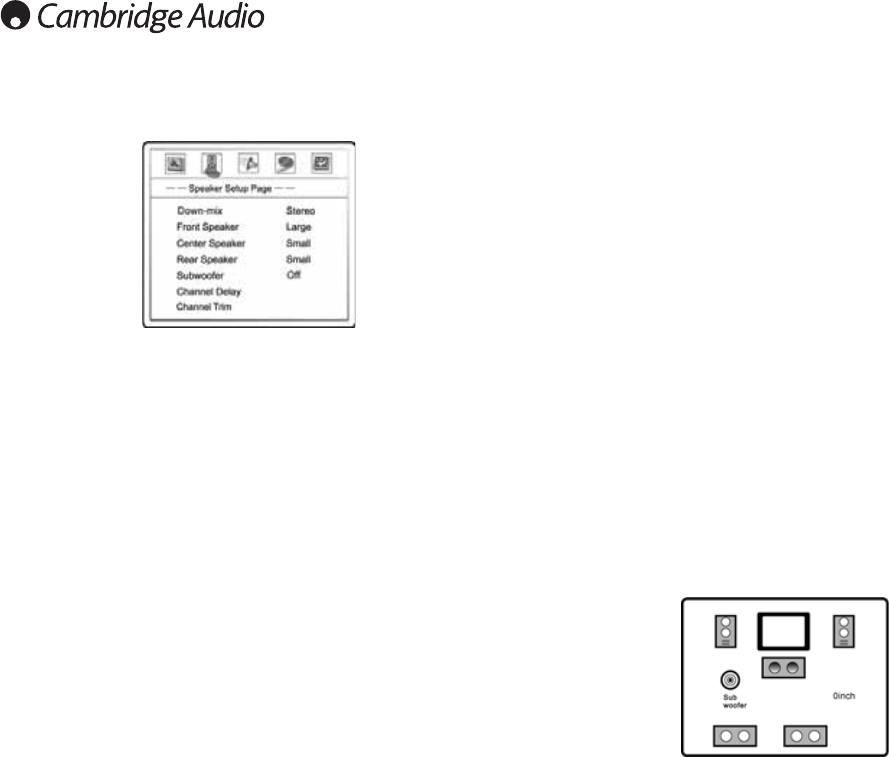
8
Speaker setup page
1. Down-mix Mode: This sets the audio down-mix mode to convert multi-
channel audio into twochannel output. This setting only affects the
“Mixed L/R” analogue audio outputs. The options are:
• Left/Right - Left and Right channels only. This mode is intended for
use with two-channel Dolby Pro Logic receivers. If the content is
encoded with Dolby Pro Logic then the encoded audio will be correctly
preserved and passed to the receiver for Dolby Pro Logic processing.
For stereo content the output will be stereo.
• Stereo - This mode down-mixes decoded multi-channel (5.1ch) audio
to 2-channel stereo output. For stereo content the output will be
stereo. For multi-channel content the surround and center channels
will be mixed with the left and right front channels. Recommended for
use with TV sets or stereo receiver/amplifiers.
• V. Surround - Virtual Surround. This mode creates a virtual surround
effect from stereo or multi-channel audio contents.
• 5.1CH – This mode enables 5.1ch decoded analogue audio output.
The number of actual output channels depends on the disc. Note: For
multi-channel content, only the left front and right front channels will
be re-produced from the Down-mix outputs. If you are using two
speakers and don’t hear dialogue or vocals, double check that this
mode is not engaged.
Analogue multi-channel output settings
The following settings only affect the analogue multi-channel outputs,
not the digital coaxial or optical outputs of the DVD player. We
recommend using the analogue multi-channel outputs of this player only
when you are playing SACD or DVD-Audio discs and/or cannot utilize
HDMI or the digital audio outputs with your audio system.
2. Front Speaker: To set the sound filtering control for the front
speakers. The options are:
• Large – Choose if the front speakers are full range (reproduce down
to at least 40Hz) and if you do not have a subwoofer. Bass frequencies
are passed to the front speakers.
• Small – Choose if the front speakers are not “full range” speakers
(almost all speakers qualify to be “small”). Bass frequencies are not
passed to the front speakers to reduce possible distortion. This is the
preferred setting for all systems utilizing a subwoofer.
3. Center Speaker: To set the sound filtering control for the center
speaker. The options are:
• Large – Choose if the center speaker is full range (reproduces down
to at least 40Hz) and if you do not have a subwoofer. Bass frequencies
are passed to the center speaker.
• Small – Choose if the center speaker is not a “full range” speakers
(almost all center channels qualify to be “small”). Bass frequencies
are not passed to the front speakers to reduce possible distortion.
This is the preferred setting for all systems utilizing a subwoofer.
• Off – Choose if there is no center speaker. This sends Center Speaker
information to the Front Speaker outputs.
4. Rear Speaker: To set the sound filtering control for the rear speakers.
The options are:
• Large – Choose if the rear/surround speakers are full range
(reproduce down to at least 40Hz) and if you do not have a subwoofer.
Bass frequencies are passed to the rear speakers.
• Small – Choose if the rear/surround speakers are not “full range”
speakers (almost all speakers qualify to be “small”). Bass frequencies
are not passed to the rear speakers to reduce possible distortion.
• Off – Choose if there are no rear speakers. This sends Rear Speaker
information to the Front Speaker outputs.
5. Subwoofer: To enable/disable the Subwoofer output. The options are:
• On – Subwoofer output is enabled.
• Off – Subwoofer output is disabled.
6. Channel Delay: This feature, which is displayed in inches, sets the
delay time for the Center and Rear speakers as well as the Subwoofer.
The delay is to compensate for differences between the distance of
the Front speakers to the listening position, and the distances
measured by the other speakers in the system (Center, Surrounds
and Subwoofer).
• Measure the distance (in inches) from the primary listening position
to the Front Left Speaker. This is your baseline measurement – the
primary distance that will determine the adjustments for your system.
Your Front Right and Left speakers should measure the same
distance. If they do not, please adjust them if possible.















